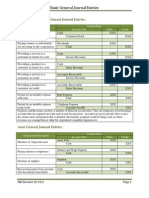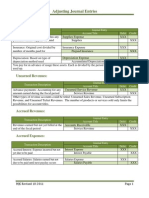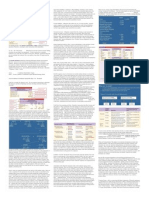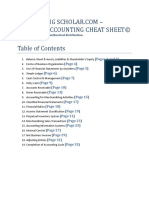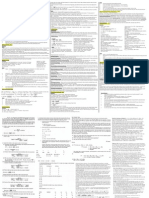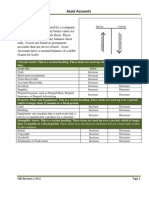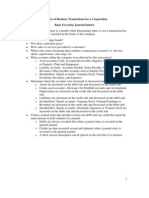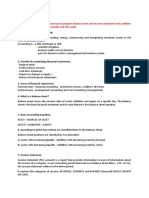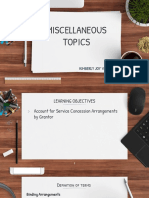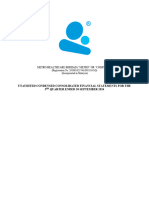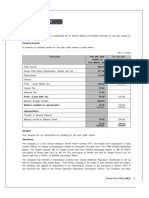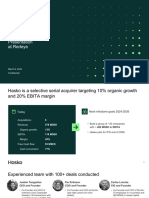Cheat Sheet Exam 1
Cheat Sheet Exam 1
Uploaded by
Shashi Gavini KeilCopyright:
Available Formats
Cheat Sheet Exam 1
Cheat Sheet Exam 1
Uploaded by
Shashi Gavini KeilCopyright
Available Formats
Share this document
Did you find this document useful?
Is this content inappropriate?
Copyright:
Available Formats
Cheat Sheet Exam 1
Cheat Sheet Exam 1
Uploaded by
Shashi Gavini KeilCopyright:
Available Formats
*Accounting- a systems that collects and processes (analyzes, measures, and records) financial information about an organization and
reports that information to decision makers. -Accounting system: Financial Acct Reports (periodic financial statements & related disclosures) Managerial Acct Reports- detailed plans & continuous performance reports Internal decision makers- managers External decision makers- investors, creditors, suppliers, and customers -Four Basic Financial statements: (Statement of financial position) 4. Statement of Cash Flows 1. Balance Sheet (Assets= Liabilities + Stockholders equity) (Basic accounting equation) -operation-directly relate to earning income -financing provided by owners/ investors= equity 2. Income Statement (Revenues- Expenses=Net Income) - investing- acquisition or sale of companys assets -retained earnings are reinvested in company -aka- statement of earnings, statement of operations/ income -financing- ex: payment to investors/ creditors. (except -Net income doesnt usually= net cash generated by operations suppliers) 3. Statement of Retained Earnings (Begin RE + Net Income-Dividends= End RE) - end RE is found on balance sheet under SE Relationship b/w sheets: Notes provide supplimental info abt financial conditons w/ formatting: out which the financial statements cannot be fully undstood. assets listed by liquidityease of turning into $ 3 types of notes: -liabilities- maturity (how soon to be paid off) 1. provides description on accounting rules Why is GAAP impt? 2. additional details about a line on financial statements - effects the selling price of stock 3. additional financial disclosures about items not listed. effects on the amt of bonuses received by mgmt *GAAP- are the measurement rules used to develop the -loss of competitive info to other companies information in financial statements. 3 steps of accuracy: *SEC- U.S gov. agency that determines the financial system of controls, external auditors, board of statements that public companies must provide to auditors. stockholders and the measurement rules that they must use in producing those statements. *FASB- financial accounting standards board is the private sector body given the primary respinsibulity to work out the detailed rules that become GAAP. *Audit- an examination of the financial reports to ensure that they represent what they claim and conform with GAAP Types of business entities: Price Earnings Ratio: 1. sole propietership- owned by one person income overstatement x P/E ratio= overpayment 2. partnership- owned by two or more persons known as partners - can determine the value of a company 3. corporation- Owners are shareholders/stockholders. Ownership is respresented by shares of capitol stock. -primary responsibility of the companys finicail statements lies within the companys management Objective of External Financial Reporting: *Relevant: info that can influence a decision; it is timely and have predictive value -To provide useful economic information to external users for decision making *Reliable: info is accurate, unbiased, and verifiable. Qualitative Characteristics of Financial Information: *Separate entity assumption- business transactions are accounted for separately from the - Relevant, Reliable, Comparable, and Consistent transactions of owners. Elements to Be Measured and Reported: *Unit of measure assumption- acct info should be measured in the nation monetary unit -Assets, Liabilities, SE , Revenues, Expenses, Gains, and Losses *Continuity Assumption- businesses are assumed to continue to operate into the future. Concepts for Measuring and Reporting Information: *Time period assumption- guidance on measuring revenues and expenses. - Assumptions: Separate-entity, Unit-of-measure, Continuity, Time Period *Historical cost principle- requires assets to be recorded at the historical cost-cash paid -Principles: Historical Cost, Revenue Recognition, Matching, Full Disclosure + the current $ value of all noncash considerations given on the date of the exchange -Exceptions: Cost-benefit, Materiality, Conservatism, Industry Practices *Materiality- says that small amounts that are not likely to influence a users decision can *Current Asset- will be turned into $ within one year be accounted for in the most cost- beneficial manner. *Long-term assets- ex: property, equipment, notes relievable, intangibles *conservatism- says that care should be taken not to overstate liabilities and expenses. TRANACTION-1. An exchange of assets or services for assets, services, or promises to pay b/w business / 2. A measureable internal event such as the use of assets in operations *External- exchanges of assets, goods, or services by one party to another Special examples: * Internal not direct exchanges, ex: using up paid insurance, using buildings and equipment for several years. Liabilities: ex: payable, unearned. *Account- standardized formant that originations use to accumulate the $ effect of transactions on each financial statement item. Assets: ex: receivables, prepaid expenses Principles of Transaction Analysis Assets (A) = Liabilities (L) + Stockholders Equity (SE) Duel Affect: entity both receives something and gives up something in return. 1. Every transaction affects at least two accounts; correctly identifying those accounts and the direction of the effect (whether an increase or a decrease) is critical. 2. The accounting equation must remain in balance after each transaction. ***the exchange of two promises to perform does not result in an accounting transaction Transactions that occur b/w company and external parties are recorded in general journal in chronological order ; Related accounts are updated in general ledger Current Ratios: =current assets/ Journal Entry: current liabilities -helpsT Table: if company currently has deter mine resources pay to back short term debt ; want it to be b/w1.0-2.0. Over 2 ratio is too high indicating poor use of resources. A # below 1.0 shows sufficient use of liquidity.
You might also like
- Accounting Cheat SheetDocument7 pagesAccounting Cheat Sheetopty100% (17)
- Ultimate Accounting Guide SheetDocument1 pageUltimate Accounting Guide SheetMD. Monzurul Karim Shanchay71% (7)
- Basic Everyday Journal EntriesDocument2 pagesBasic Everyday Journal EntriesMary73% (15)
- Inbm 110 - Accounts Study Sheet: Chapter 1 & 2Document5 pagesInbm 110 - Accounts Study Sheet: Chapter 1 & 2Laura Tai100% (1)
- Closing Journal EntriesDocument1 pageClosing Journal EntriesMary91% (11)
- Cheat Sheet Final - FMVDocument3 pagesCheat Sheet Final - FMVhanifakih100% (2)
- CorpFinance Cheat Sheet v2.2Document2 pagesCorpFinance Cheat Sheet v2.2subtle69100% (4)
- Diagram of Accounting EquationDocument1 pageDiagram of Accounting EquationMary100% (3)
- Accounting Journal Entries Flowchart PDFDocument1 pageAccounting Journal Entries Flowchart PDFMary83% (6)
- Account ClassificationDocument2 pagesAccount ClassificationMary96% (25)
- CPA Review Notes 2019 - FAR (Financial Accounting and Reporting)From EverandCPA Review Notes 2019 - FAR (Financial Accounting and Reporting)Rating: 3.5 out of 5 stars3.5/5 (17)
- Adeola Company ProfileDocument90 pagesAdeola Company ProfileRichard WakoriNo ratings yet
- Intermediate Accounting 1: a QuickStudy Digital Reference GuideFrom EverandIntermediate Accounting 1: a QuickStudy Digital Reference GuideNo ratings yet
- Intermediate Accounting 2: a QuickStudy Digital Reference GuideFrom EverandIntermediate Accounting 2: a QuickStudy Digital Reference GuideNo ratings yet
- Cheat Sheet For AccountingDocument4 pagesCheat Sheet For Accountingshihui100% (1)
- CheatDocument1 pageCheatIshmo KueedNo ratings yet
- Kelly's Finance Cheat Sheet V6Document2 pagesKelly's Finance Cheat Sheet V6Kelly Koh100% (4)
- ACCT 101 Cheat SheetDocument1 pageACCT 101 Cheat SheetAndrea NingNo ratings yet
- Journal Entry Format PDFDocument1 pageJournal Entry Format PDFMaryNo ratings yet
- Bec Review SheetDocument7 pagesBec Review Sheettrevor100% (1)
- Cheat Sheet For Financial AccountingDocument1 pageCheat Sheet For Financial Accountingmikewu101No ratings yet
- Adjusting Journal EntriesDocument1 pageAdjusting Journal EntriesMary100% (3)
- Financial Accounting Modules 1-5 Study NotesDocument21 pagesFinancial Accounting Modules 1-5 Study NotesLisaNo ratings yet
- Financial Accounting: Tools For Business Decision-Making, Third Canadian EditionDocument6 pagesFinancial Accounting: Tools For Business Decision-Making, Third Canadian Editionapi-19743565100% (1)
- Ratios Used in Analysis of Financial StatementsDocument2 pagesRatios Used in Analysis of Financial StatementsMary100% (4)
- Accounting Cheat SheetsDocument4 pagesAccounting Cheat SheetsGreg BealNo ratings yet
- ACC1002X Cheat Sheet 2Document1 pageACC1002X Cheat Sheet 2jieboNo ratings yet
- Accouting Finals Cheat SheetDocument1 pageAccouting Finals Cheat SheetpinkrocketNo ratings yet
- Accounting Cheat SheetDocument2 pagesAccounting Cheat SheetvgirotraNo ratings yet
- General Accounting Cheat SheetDocument35 pagesGeneral Accounting Cheat SheetHectorNo ratings yet
- Accounting Cheat Sheet FinalsDocument5 pagesAccounting Cheat Sheet FinalsRahel Charikar100% (1)
- End of The Year Adjustment For Allowance For Doubtful AccountsDocument1 pageEnd of The Year Adjustment For Allowance For Doubtful AccountsMary100% (1)
- Basic Instructions For Retained Earnings StatementDocument1 pageBasic Instructions For Retained Earnings StatementMary100% (5)
- Fnce 100 Final Cheat SheetDocument2 pagesFnce 100 Final Cheat SheetToby Arriaga100% (2)
- Journal EntriesDocument2 pagesJournal EntriesNafis Hasan50% (2)
- Asset Accounts With Normal BalancesDocument2 pagesAsset Accounts With Normal BalancesMary100% (2)
- Analyzes of A Business TransactionDocument13 pagesAnalyzes of A Business TransactionMary100% (1)
- Cash Flows Statement Indirect MethodDocument2 pagesCash Flows Statement Indirect MethodMary100% (1)
- Corporate Finance - FormulasDocument3 pagesCorporate Finance - FormulasAbhijit Pandit100% (1)
- Financial Accounting 3Document47 pagesFinancial Accounting 3Roxana Istrate100% (1)
- Financial Accounting Workbook PDFDocument89 pagesFinancial Accounting Workbook PDFDianne Jonnalyn Cuba100% (1)
- General Accounting Cheat SheetDocument35 pagesGeneral Accounting Cheat SheetZee Drake100% (6)
- Understanding Financial StatementsDocument77 pagesUnderstanding Financial Statementsshivam_dubey4004100% (1)
- Accounting CheatsheetDocument1 pageAccounting Cheatsheetalbatross868973No ratings yet
- BVA CheatsheetDocument3 pagesBVA CheatsheetMina ChangNo ratings yet
- Class of AccountsDocument5 pagesClass of AccountssalynnaNo ratings yet
- BEC NotesDocument17 pagesBEC NotescsugroupNo ratings yet
- Stockholders' Equity Accounts With Normal BalancesDocument3 pagesStockholders' Equity Accounts With Normal BalancesMary67% (3)
- Acct1501 Notes: 1. Introduction To Financial AccountingDocument11 pagesAcct1501 Notes: 1. Introduction To Financial AccountingLena ZhengNo ratings yet
- FINANCIAL REPORTING - ScriptDocument9 pagesFINANCIAL REPORTING - ScriptMutesa ChrisNo ratings yet
- Summary Intermediate Financial AccountingDocument10 pagesSummary Intermediate Financial AccountingRenz EdilloNo ratings yet
- CMA Notes Unit 1Document29 pagesCMA Notes Unit 1mesharysjNo ratings yet
- General Purpose Financial Statements (Basic Financial Statements)Document3 pagesGeneral Purpose Financial Statements (Basic Financial Statements)Jolly CharmzNo ratings yet
- Acct 15Document15 pagesAcct 15academicexcellence21No ratings yet
- ACCG611 Notes: Introduction To AccountingDocument13 pagesACCG611 Notes: Introduction To AccountingANo ratings yet
- ACCOUNTING-WPS OfficeDocument6 pagesACCOUNTING-WPS OfficeNorjehanie AliNo ratings yet
- Introduction to AccountingDocument43 pagesIntroduction to AccountingLong NguyenNo ratings yet
- ACTBAS1 ReviewerDocument12 pagesACTBAS1 ReviewerRhobeMitchAilarieParelNo ratings yet
- Tut 8 Submission QuestionsDocument6 pagesTut 8 Submission Questionsxabaandiswa8No ratings yet
- Prospective Analysis - FinalDocument7 pagesProspective Analysis - Finalsanjana jainNo ratings yet
- Beiersdorf Annual-Financial-Statements-2020Document41 pagesBeiersdorf Annual-Financial-Statements-2020edi_wsNo ratings yet
- Service ConcessionDocument31 pagesService ConcessionAngelica AllanicNo ratings yet
- BP CLD ENTPR S4CLD1808 13 Process-Steps EN USDocument830 pagesBP CLD ENTPR S4CLD1808 13 Process-Steps EN USRiteshSinhmarNo ratings yet
- CH 3 - Change in Profit Sharing Ratio Among PartersDocument4 pagesCH 3 - Change in Profit Sharing Ratio Among PartersAmna SarfrazNo ratings yet
- Faf Tutorial 3 Ifrs 16Document4 pagesFaf Tutorial 3 Ifrs 16嘉慧No ratings yet
- Crest Nicholson Holdings Annual Report (2009)Document39 pagesCrest Nicholson Holdings Annual Report (2009)Forko ForkovNo ratings yet
- Jfp463e SlideDocument155 pagesJfp463e SlideHino EijiNo ratings yet
- ProForma NTDocument18 pagesProForma NTCosmin TurcuNo ratings yet
- ACCT 1002 - Introduction To Financial Accounting - COURSE SCHEDULE - Semester 1 2022 - 2023Document3 pagesACCT 1002 - Introduction To Financial Accounting - COURSE SCHEDULE - Semester 1 2022 - 2023Claire CumminsNo ratings yet
- Cost Accounting Notes For StudentsDocument41 pagesCost Accounting Notes For StudentsDipak K. Sah100% (2)
- 253489401-Year-End-Closing-Activities-in-Sap-Fi-CoDocument30 pages253489401-Year-End-Closing-Activities-in-Sap-Fi-Coann.aliNo ratings yet
- Consolidated Balance Sheet: (All Amounts in Million of Indian Rupees, Unless Otherwise Stated)Document1 pageConsolidated Balance Sheet: (All Amounts in Million of Indian Rupees, Unless Otherwise Stated)Pranav ChopraNo ratings yet
- 629 19PCM10 19PCZ09 Mcom Mcom CA 05 02 2022 FNDocument19 pages629 19PCM10 19PCZ09 Mcom Mcom CA 05 02 2022 FNMukesh kannan MahiNo ratings yet
- Test Bank Solutions For Government and Not For Profit Accounting Concepts and Practices 5thDocument25 pagesTest Bank Solutions For Government and Not For Profit Accounting Concepts and Practices 5thAnonymous 1m13hVlta760% (5)
- SAP Asset History Sheet (S - ALR - 87011990)Document3 pagesSAP Asset History Sheet (S - ALR - 87011990)inasapNo ratings yet
- Metro Healthcare Berhad Q3 2024Document21 pagesMetro Healthcare Berhad Q3 2024Ojong JefNo ratings yet
- Ratio Analysis XII Class NotesDocument36 pagesRatio Analysis XII Class NotesRajesh NangaliaNo ratings yet
- Pract 1Document12 pagesPract 1Kylie TarnateNo ratings yet
- Financial & Managerial Accounting: Information For DecisionsDocument79 pagesFinancial & Managerial Accounting: Information For DecisionsMarnelli PerezNo ratings yet
- Final Exam - Acc115Document7 pagesFinal Exam - Acc115angelapearlrNo ratings yet
- CCN 1014402Document11 pagesCCN 1014402richard87bNo ratings yet
- April 2023 FS CANTEEN REportDocument5 pagesApril 2023 FS CANTEEN REportYyahm YserolfNo ratings yet
- Lecture 5 - Accounting Analysis 3Document29 pagesLecture 5 - Accounting Analysis 3JF FNo ratings yet
- Torrent Power Grid Limited - Annual Report 2009-10Document24 pagesTorrent Power Grid Limited - Annual Report 2009-10rajbank6_sNo ratings yet
- Overview of Financial Statements: Fin 104ADocument19 pagesOverview of Financial Statements: Fin 104AJaki Villanueva MataNo ratings yet
- 08.50 Hasko InvestDocument17 pages08.50 Hasko InvestPatrick GroveNo ratings yet
- Preventive Maintenance SetupDocument32 pagesPreventive Maintenance SetupAbu SiddiqueNo ratings yet


